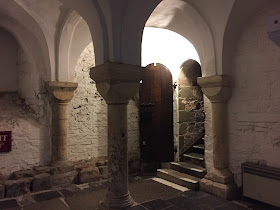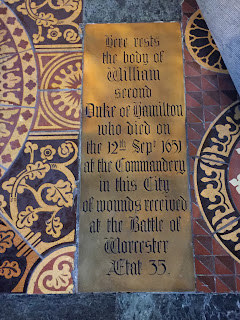 |
|
Severn River © Cryssa Bazos
|
On the banks of the Severn River stands a magnificent cathedral. Framed against a river of gliding swans, Worcester Cathedral's history has spanned centuries, serving as the final resting place for royalty and providing a backdrop for major conflicts.
 |
| Worcester Cathedral © Cryssa Bazos |
Even before the present day cathedral, the site was consecrated by a priory founded in the 7th century. Nothing now remains of this original priory, but in the 10th century, a new church was built by Saint Oswald, the Bishop of Worcester. The subterranean crypt is the only part of that earlier structure still remaining. It's a hauntingly quiet niche still used for worship.
 |
| The Crypt © Cryssa Bazos |
 |
| The Crypt © Cryssa Bazos |
 |
| Statue in the Crypt © Cryssa Bazos |
Another saint associated with Worcester was an Anglo Saxon bishop, Saint Wulfstan who held this see before and during the Norman Conquest. Despite his allegiance to Harold Godwinson (of the Battle of Hastings fame), Wulfstan held his post under William the Conqueror.
This stained glass panel commemorates both saints.
 |
| Stained glass saints © Cryssa Bazos |
Work on the present day cathedral started in 1084 and was finished by 1504. It is a work of art as one can see by the magnificent vaulted quire ceiling, which is decorated with the images of saints and angels.
And now to visit the cathedral's famous residents. King John, also known as John Lackland, Prince John, and signer of the Magna Carta, is buried in Worcester Cathedral. His sarcophagus is decorated with his likeness, carved in Portland stone. At one time, the stone would have been painted, but now has darkened to the colour of agate.
King John was a poor monarch and his reign was punctuated by periods of revolt . Though he did sign the Magna Carta, he did so under duress, forced to do so by his barons who had had enough of his abuse. He died shortly after trying to launch a fresh attack on the rebel barons.
What is interesting about his effigy is that the two Worcester saints, Oswald and Wulfstan, have been included, sitting on each shoulder of the king. Proof that John Lackland needed all the help he could get for the afterlife.
 |
| Detail of King John's tomb © Cryssa Bazos |
 |
| King John's tomb © Cryssa Bazos |
 |
| Royal crest on King John's tomb © Cryssa Bazos |
A better mourned royal in Worcester Cathedral is Prince Arthur, the older brother of Henry VIII. Prince Arthur died suddenly at the age of 15, only five months after his marriage to Catharine of Aragon. His death was a crushing blow to his father, Henry VII.
After lying in state at Ludlow castle, Prince Arthur's body was brought to Worcester Cathedral by boat. The Prince had a connection to the city since he had been baptized by the Bishop of Worcester, and as a child, he had spent time in the city. During his funeral, dirges were sung for him. His tomb lies in the chantry chapel and is decorated by the white and red roses of York and Lancaster.
 |
| Prince Arthur's tomb © Cryssa Bazos |
 |
| Heraldic motif Prince Arthur's tomb © Cryssa Bazos |
Imagine what might have happened had he lived. Henry VIII would not have been king, would not have married Arthur's widow, Catherine, and subsequently broken from the Catholic church for the sake of Anne Boleyn. The country may have gone down a different path, one perhaps not driven by religious conflicts.
The final grave I'd like to visit belongs to the Duke of Hamilton, killed during the final battle of the English Civil War.
The first battle of the civil war was fought in 1642 just south of Worcester Cathedral at Powick Bridge. The last battle of the civil war was fought at Worcester on September 2, 1651. During the week leading up to the final battle, King Charles II occupied Worcester with 12,000 - 14,000 Scottish soldiers. William Hamilton, the 2nd Duke of Hamilton, was a close friend of the king and led a regiment on his behalf.
During the early stages of the battle, King Charles observed the fighting to the south from the strategic vantage of the cathedral's tower, with its sweeping views of the area. When he gauged the time right, King Charles led an assault against Cromwell's forces at Red Hill (to the east of the city) while the Duke of Hamilton led an assault against Perry Wood.
The Duke was shot during the engagement, and his men brought him back to his lodgings in the Commandery (just outside Worcester's Sidbury Gate) which was now overrun by the victorious Parliamentary soldiers.
At the Commandery, a Royalist surgeon examined him and found a musket shot had shattered in the leg and the only way to save him would be to amputate. Cromwell's physician examined him as well, but disagreed with the prognosis and told him that he didn't need to lose the leg. Hamilton worsened and subsequently died of his injuries. Another version of this story was that Hamilton declined Cromwell's offer of his surgeon, determined not to be treated by a traitor.
On his deathbed, the Duke had barely enough energy to write a heart-wrenching farewell letter to his wife. The letter was found in his pocket after he passed away.
Dear Heart,
YOV know I have been long labouring, though in great weakness, to be prepared against this expected Change, and I thank my God I find Comfort in it, in this my day of Tryal; for my Body is not more weakned by my Wounds, then I find my Spirit Comforted and Supported by the infinite Mercies and great Love of my Blessed Redeemer, who will be with me to the end and in the end.
I am not able to say much more to you, the Lord preserve you under your Tryals, and sanctifie the use of them to the Comfort of your Soul.
I will not so much as in a Letter divide my dear Neeces and you; the Lord grant you may be constant Comforts to one another in this Life, and send you all Eternal Happiness with your Saviour in the Life to come: to both of your Cares I recommend my poor Children, let your great Work be to make them early accquainted with God, and their Duties to him; and though they may suffer many wants here before their Removal from hence, yet they will find an inexhaustible Treasure in the Love of Christ. May the Comforts of the Blessed Spirit be ever near you in all your Straits and Difficulties, and suffer not the least repining to enter into any of your Hearts for his Dispensations to|wards me, for his Mercies have been infinitely above his Iustice in the whole Pilgrimage of,
Dear Heart, Your Own, HAMILTON.
Worcester, Sept. 8. 1651.
Against his wishes for his body to be returned to Scotland, the Duke was buried in Worcester Cathedral. His servants repeatedly petitioned Cromwell to approve the transfer of the Duke's body to his wife but the request was denied. A single plaque marks where he was buried.
 |
| Duke of Hamilton plaque © Cryssa Bazos |
Worcester Cathedral has a long, rich history to explore. The next time you are visiting Worcester, I encourage you to take a detour and visit the past.
 |
| Worcester Cathedral interior © Cryssa Bazos |
~~~~~~~~~~
Cryssa Bazos is a historical fiction writer and 17th Century enthusiast with a particular interest in the English Civil War (ECW). For more stories about the English Civil War and the 17th Century, visit her blog.
Cryssa, I can only imagine the awe inspiring experience of standing in this cathedral so rich in history. Magnificent
ReplyDeleteIt was wonderful. The architecture and the history was incredible, especially seeing the Duke of Hamilton's plaque which is normally hidden from view.
ReplyDelete